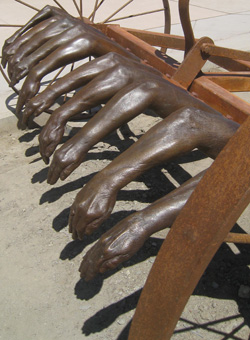
Bay Area artist Valerie Raps recently completed a public art commission for the Alum Rock History Corridor Project.
Cultivating Community is a life-size, stylized spring tooth harrow created from fabricated steel and cast bronze. The tines of the harrow are made from casting the arms of ten San Jose community members. The sculpture is located at Tropicana Shopping Center in East San Jose.
Raps has a MFA from San Jose State University and a MA in Holistic Counseling from JFK University. She is also the Resident Curator of Art Ark Gallery in San Jose.
Whirligig: You recently completed a commission for a sculpture for the Tropicana Shopping Center. Tell us about this project.
Valerie: The project was commissioned by the City of San Jose Office of Cultural Affairs in collaboration with Don Imwalle, who is the property owner of the northeast corner of Tropicana Shopping Center on King and Story Roads in San Jose.
About three years ago the city put out a call for participation for submissions to be part of an artists catalogue. They selected 30 out of 300 applicants for this catalogue which was then made available to developers who build commercial and residential spaces. I was one of three artists to present proposals for a public art project for the Tropicana Shopping Center. The site is part of a larger project called the Alum Rock Cultural History Corridor, an area in East San Jose which has pinpointed several locations for public funds to commenorate the rich and diverse history of the area.
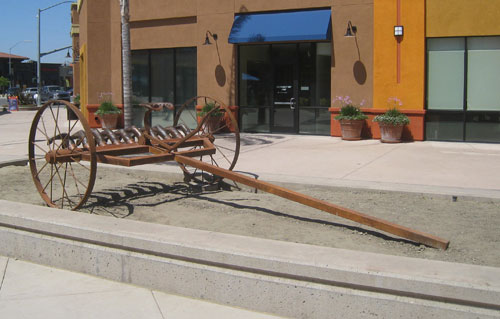
My art in the catalogue represented my MFA thesis work which was literally a series of hand tools representing members of my family. Each member of my family offered themselves as a tool which I created by casting their hands and then fashioning them into the tools they were meant to represent. My mother is a trowel. My grandma is a rake. My grandpa is a post digger . . .
The theme for the public art project at the Tropicana Shopping Center was to commemorate the area’s agricultural history. I proposed creating a farm implement which incorporated the arms of individuals who had historical significance to the area. The arm of each individual would become a tine of a stylized spring tooth harrow. The sculpture would symbolically depict the human labor force behind the machine.
Whirligig: How did you come up with the concept?
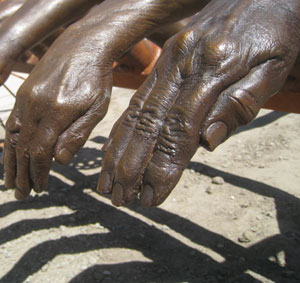 Valerie: Brainstorming with a couple of friends. We talked about past work that I have done and what Imwalle and the city had seen, the hand tools, and how I might take that a step further. I wanted to do a spin off of the hand tools but instead of creating portraits of individuals, I wanted to articulate the idea of community and cultivating land.
Valerie: Brainstorming with a couple of friends. We talked about past work that I have done and what Imwalle and the city had seen, the hand tools, and how I might take that a step further. I wanted to do a spin off of the hand tools but instead of creating portraits of individuals, I wanted to articulate the idea of community and cultivating land.
I started tossing around agricultural ideas. I thought of other tools and machines. I began to explore how I could modify an existing farm implement to depict the human workforce behind the machine since tools are an extension of the human hand.
The spring tooth harrow’s purpose is to comb or rake top soils, and collect weeds or grass, as opposed to a cultivator, whose purpose is to turn and churn soil. It seemed like an elegant visual symbol to show individuals putting forth their hands into the soil, playing a part to plant and reap the produce that we all enjoy.
East San Jose’s history includes usage as a combiniation of dairy land and fruit orchards. This also leads into the work of Cesar Chavez, who was an activist for farm workers rights, especially the migrant labor force. So the work touches upon that. It is also meant to elevate blue collar laborers, who often are under appreciated. Yet, without that sector of the work force nothing would be possible.
I feel an alignment with the idea of not elevating the one, but the many.
Whirligig: What challenges did you face?
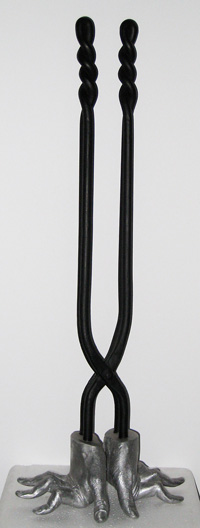
Valerie: Not knowing how to select the participants who would represent the masses. I needed ten important people who, if not direct descendants of historical figures involved in San Jose’s agricultural history, were somehow involved with it today.
There was a little confusion with the city as to who would choose the ten people. I felt uncomfortable deciding which ten individuals would represent the whole popluace. At one time in the project, I thought I would just go down to the fields in Gilroy and hire day laborers. I would pay them a day’s wage to cast their arms. At the same time I appreciated that the city wanted to acknowledge families in the community who had a long lineage in local activism and agriculture. So they ended up helping me select those people.
The final participants include: Rudy Medina, Cesar Chavez’s nephew; Rita Chavez, Cesar Chavez’s sister; Librado Chaves, Cesar Chavez’s brother; Hermelinda Sapien, Executive Director, CET: Center for Employment Training; Steve Arevalo, Filipino Farmworker Activist; Raul Lozano, La Mesa Verde; Mark Anthony Medeiros, Farm Manager, Veggielution; Rosa Campos, East San Jose Neighborhood Resident; Hank Imwalle, Fruit and Vegetable Distributer; and Chelan Addleman, Mayfair Neighborhood Resident.
Another challenge was the time line. Working with the city, like any other beauracy, was difficult be it scheduling meetings, getting approval to move forward or receiving funding to do so. There were a lot of delays that happen along the way. The whole project took from December 2009 to June 2011. We are still waiting to find a date for the dedication and commemoration ceremony. (Held on October 29, 2011.)
I had no idea it would take so long to get through concept review and schematic review. My eyes are now open to the process of creating a public art project: finding an engineer, subcontracting labor, insurance, keeping a budget, writing contracts, and communicating effectively.
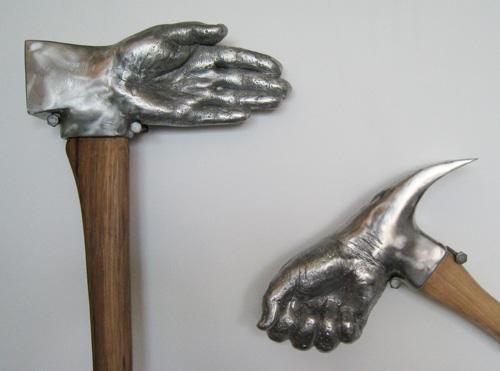
The other major obstacle with public art is that it is not a full time job and so you can’t treat it as one. I was working 50 hours a week at a full time job and running Art Ark Gallery while fabricating the piece. It was the most demanding year of my life just trying to keep up day in, day out. Then there was the learning curve of making a public art piece, and engaging with so many different people such as structural engineers and insurance people, committee members and my project manager.
Maintaining a balanced life was difficult. I can only imagine, but I think it’s equivalent to having a child where the child demands all of your time, it takes over your sleep, work patterns, and you have to add it on to your pre-existing work load.
One thing I loved about the project was the social engagement. I met so many people during the installation. People walking by would stop and ask questions about the piece and what I was doing. It led to very interesting conversations. One person shared, “My grandfather picked berries and he lost his arm in a machine. He was the fastest strawberry picker there was and everybody admired him. . . ” The sculpture is a great conversation piece. I think it reads universally about celebrating the human labor behind the machine that toiled the land.
Whirligig: How did you come to be an artist? What were your influences?
Valerie: I don’t think of being an artist as my profession because at this point it is not a money making endeavor. It is the pure joy and excitement of being able to make something, in this case a sculpture, that would be outside of a museum or a gallery and be visible and accessible to all. I love that.

My concept of being an artist is about exploring the relationship between objects. I enjoy manipulating forms, shapes, textures, weight, value and functions to achieve interesting relationship dynamics. I am continuously rearranging the furniture in my house to create new environments that support my current needs for space and aesthetic values. I believe in the art and science of feng shui. I am very aware of how the shape of space affects my mood, creativity and well being.
Whirligig: How did you go from being a fifth grade teacher to getting an MFA in sculpture.
Valerie: During that one year I taught fifth grade my students learned a lot about art. I exposed them to the murals in Balmy Alley in San Francisco, and reflected on how art creates culture. I received money from the PTA to paint a mural at the school. My students explored what images and symbols represented them, their family, their neighborhood. Together we created and painted a mural that reflects their identities. That one year of teaching taught me that my passion lies in art. I left with the feeling that I needed to focus on what I do best, as it was overwhelming teaching multiple subjects to fifth graders. So I decided I would get a MFA and try teaching at the college level. When I got to that point I saw all of my colleagues competing, cutthroat, for limited teaching positions. I decided I was not that passionate about working with college age students. Eighteen year olds are more interested in their own evolving process than the subject matter of the class. So then I jumped into a second masters program and got a MA in psychology which was quite a journey of personal growth. My thesis was titled Using Public Art as a Holistic Healing Tool to Build Unity in Multi-Culturally Diverse Communities.
Whirligig: That was through JFK University?
Valerie: Yes, it was.
Whirligig: You engage in multiple roles—artist, gallery curator, therapist. How do you manage and prioritize these?
Valerie: (giggles.) Not very well. It’s hard to give each area of life 100%. It seems to take turns, shifting between priorities and deadlines.
Whirligig: If you could move to one of these full time and let the others go, which would it be?
Valerie: I think I like the variety. Lists get made in the order of deadlines. It means that maybe the house doesn’t get cleaned for eight months, but public art gets made. Luckily I have found a steady rhythm with Art Ark Gallery: a cycle of preparing for shows and receptions. It’s a familiar routine. It’s alway difficult making time for everything. It seems to ebb and flow. Sometimes family and friends demand priority. Sometimes deadlines for work or deadlines for art. I think that is how art gets made at this point. In my life it is not a daily practice, but rather short surges of energy to meet benchmarks and deadlines. Having deadlines for exhibitions or installations dictates the work flow. It’s not always a balanced and sometimes getting sick along the way or having a back injury are side effects of doing too much at once.
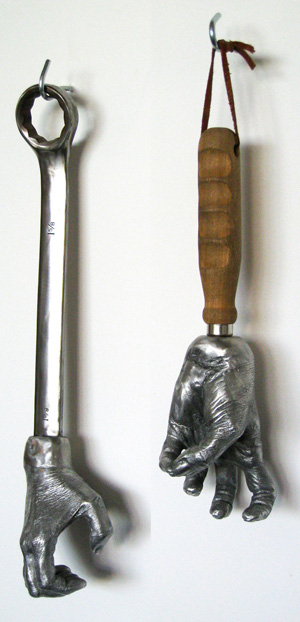
I guess ideally, I would work part time as a therapist, part time in the gallery, and part time as an artist. Working full time as a case manager/therapist is emotionally draining, and working with clients in the mental health system means loads of paper work. It makes it difficult to have the energy left to make art or maintain friendships. I like it when each role I play has a different rhythm, with staggering deadlines, due dates and receptions.
This next year my priority is taking care of my physical body and well being. Sometimes opporutnites knock and you get more than you can handle all at once. I can’t help but jumping in and trying it all and then deciding the amount of each to create a sustainable lifestyle.
Whirligig: How is your work as a therapist informing your work as an artist?
Valerie: I think this year’s lesson was about boundaries. How to be authentic while maintain professional boundaries. That is something that my job necessitated. I have been grappling with defining my own interpretations of professional boundaries—ethical, personal and physical. Where do I end and the world begin? How do I maintain fluidity yet clearly define myself from others in order to protect my own inner being? It’s not always an easy question to answer. I am constantly fine tuning. The more open I am the more receptive I can be. If I am too receptive, I flood my engine and stall. That is my moped analogy.
Whirligig: Do you have a moped?
Valerie: Yes. My partner got me into mopeds. There is a lot of discussion about whether the engine is running lean or rich. It is an ever changing ratio of gas and air to achieve combustion. There are many variable such as temperature, altitude and humidity. Hence, you are constantly fiddling between the two to accommodate for the present conditions. It reminds me of my teaching days as well, when after and my students stumbled back into the classroom I would hold my finger up to the wind as if to “check the climate of the class” to see how to proceed with our lessons for the afternoon.

A lot in life requires continual fine tuning. Just as some days you need more sleep than others. Like when your adreneline for a project over rides your need for sleep and allows you stay up for 48 hours and all conversation revolves around the project, its mechanics, aesthetics, and the techniques to achieve the desired results. It is enveloping.
Working with people draws me out and connects me to the world. And my art inevitably engages me with the public through exhibition or onsite installation or even with my colleagues at the foundry. Being a metal arts artist requires a lot of tools, machines and a facility and often a team to help to pour bronze or fabricate steel when making sculptures of significant size. It is an arts community that I need to keep in contact with in order to make my art. Then there is the introspective side of making art as a personal practice. The mental and emotional aspects of making. In the end they balance out—engaging with community and withdrawing into self.
Whirligig: What is most challenging and interesting about running Art Ark Gallery?
Valerie: The beauty of Art Ark is that I don’t have to worry about making rent. The gallery is part of Art Ark Apartments whose mission is to help support the artist community. The gallery provides artists with an opportunity to explore, engage, and experiment. I don’t have to make a profit off of selling art to pay the rent which allows me the freedom to take risks selecting shows.
The gallery is a beautiful space. Great light. Tall ceilings. It is conducive to stretching the possibilities of exhibition. The down side is that we don’t get much foot traffic. It does not have regular gallery hours. The gallery is only open during the reception and by appointment. There are no employees other than myself as the resident curator. It is up to the exhibiting artists to keep the gallery open during their show. We have had group shows where the artists kept gallery hours but unfortunately, not very many people came in during their hours due to the fact that the location is off the beaten path. Therefore, our reach is short. Unless the exhibiting artists have their own following the attendance is low.
Whirligig: What is the future of this space?
Valerie: That is an interesting question. It really depends on what the owner wants.
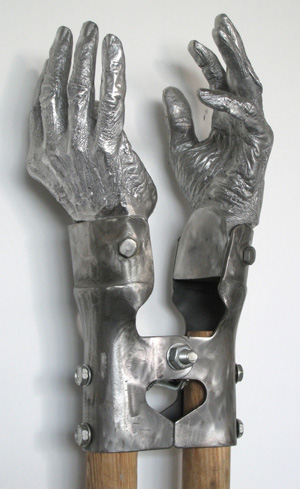 I’m currently working on extending my reach into the community by sending out call-for-proposals (cfp) to a larger audience. I recently began posting cfps on Craig’s List to participate in group shows. Up until now I have been exhibiting the work of local artists affiliated with San Jose State University, who live in the neighborhood, or who work at one of the two large art studio warehouses: The Citadel and The American Can Company. I am always looking for new artists who are interested in exhibiting their work, excited by the space, and eager to explore the possibilities.
I’m currently working on extending my reach into the community by sending out call-for-proposals (cfp) to a larger audience. I recently began posting cfps on Craig’s List to participate in group shows. Up until now I have been exhibiting the work of local artists affiliated with San Jose State University, who live in the neighborhood, or who work at one of the two large art studio warehouses: The Citadel and The American Can Company. I am always looking for new artists who are interested in exhibiting their work, excited by the space, and eager to explore the possibilities.
In order to attract artists from a wider reach, I’ll be working on developing the gallery website, marketing, and making use of social media.
It’s great when the gallery is used for other events as it increases our exposure. Being part of South First Fridays Artwalk has definitely increased our attendance. We are in our second year of participation. This has helped put us on the map.
Whirligig: You completed two very different graduate programs in a very short time. How were the programs and your experiences in them different and how were they similar?
Valerie: I was in graduate school for six years straight. My MFA began fall of 2004. In October 2007 I finished my MFA thesis and began a MA in psychology at JFK University.
Somewhere during my MFA I decided I didn’t want to teach at the collge level. I began wondering what the heck was I going to do. In retrospect my MFA was three years of art therapy. It allowed me time to focus on understanding why I make things. Why I chose the imagery, form and media I choose. How it reflects who I am. How it helps me to make sense of the world. It allowed me a lot of introspection. As well as the facilities to explore different media. Prior to my MFA I had been using a lot of mixed media found objects. At the time I was working for East Bay Depot for Creative Reuse in Berkeley. I got to comb the streets for found objects which were then sold to artists and teachers.
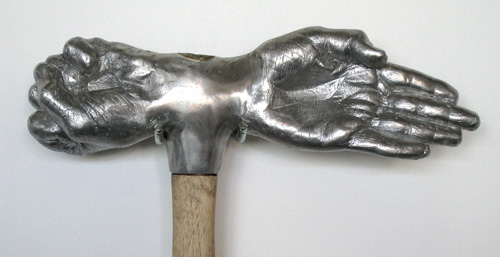
In grad school I had a foundry at my disposal again. I hadn’t done any welding or casting since my BFA at Humboldt State. It took me in a whole different direction of honing technical skills and exploring processes.
The second Masters degree helped demystify my emotions. I explored and analyzed the human psyche. Humans are a curious combination of genetics and envrionmental influence. Examining the impact of my life experiences in addition to my innate personality traits affected how I assimilated my experiences, how I reacted to them, and how I chose to respond. It changed how I engage with the world. It carved out a lot of compassion towards myself and others. Understanding helps make sense of sorrow and suffering.
The interesting thing about JFK was that we had a cohort of people. For three years we moved through the curriculum together. We got to know each other quite well as we discussed cases, ethics, laws, and did internships. It was a really interesting way to get to know your fellow classmates as layers of being were revealed. Over a three year period you are able to have some very personal conversations. You get to see how others’ life experiences contribute to the person they are today. The program provided a space for non-judgmental being—allowing individuals to grapple with contradictions. The program encouraged students to remain curious an ask questions like, why are you that way?
The MFA program had a very different flavor. It required you to justify why you are making the art you create. Reminding the student that everything has already been done before. It asked questions like, Why are you doing what you are doing in the medium you are doing it? This approach to learning put me on the defense. I recognized the professors were trying to hone you into a better artist by throwing criticisms at you so that you would get tough, if not more eloquent in speaking about your art. JFK felt much more nurturing of self discovery. Pursuing creativity was more encouraged in the program at JFK than at San Jose State.
Whirligig: Why are artists so competitive?
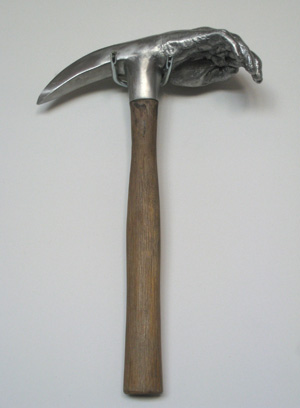 Valerie: Well I think that a long time ago artists were taught by copying masterpieces. Artists were told, “This is the ideal. Practice it until you get it right.” Today there is a need to be original and unique. Thus, you need to be able to reference similarities and differences to those who came before you and whether it is a parody or not. It becomes very political and historically based, and less about intuition and what motivates the creative process.
Valerie: Well I think that a long time ago artists were taught by copying masterpieces. Artists were told, “This is the ideal. Practice it until you get it right.” Today there is a need to be original and unique. Thus, you need to be able to reference similarities and differences to those who came before you and whether it is a parody or not. It becomes very political and historically based, and less about intuition and what motivates the creative process.
Whirligig: What was most significant in your graduate school experiences?
Valerie: The first thing that comes to mind has nothing to do directly with school. It is the death of my father. That experience colored and overlapped everything. He died abruptly while I was in my second masters program. I became more introspective as I struggled with how to deal with grief, loss, mortality, hopes, fears and disappointments. There is a finality to the loss of a being. It was a good time and place to be in a psychology program where I was able to get a lot of support while processing his passing.
I chose JFK because it offered a MA in Holistic Counseling. I think that society has this idea that holistic means alternative, granola eating, hippie, touchy-feely, spiritual, etc. which translates into not scientific, logical, factual, concrete, evidence-based data.
When I looked at the psychology program at San Jose State it was called Clinical Studies. I wanted something very different from my previous degree at San Jose State. Clinical psych emphacized dissecting and analyzing, being detached from one’s emotions and intuition. JFK offered an approach which was attempting to integrate body, mind and soul. Having grown up in western culture where mental capabilites are paramount I wanted to experience another way of seeing the world. By nature I am a very emotional being. Part of me has always felt squelched by the way I experience emotions. That part of me finally felt honored and accepted at JFK.
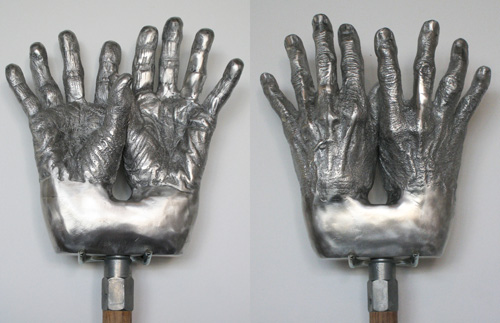
Somebody once told me this story. There once was a group of British tourists traveling in Africa. They wanted to see nine countries in seven days or something ridiculous like that. They were on a mission to see as much as possible in a very short time. One day their tour guide was sitting quietly. One of the tourists asked why he was sitting still as they were ready to leave. The tour guide said, “We cannot leave until our souls catch up with our bodies.”
I’m not sure who to credit for the story, but Western culture feels the same to me, rushed. We do not allow our souls to catch up to our bodies. We are running around soulless. We are not centered. We do not understand what motivates us to move forward. We become frenetic and imbalanced. JFKU gave me permission to integrate other parts of me other than academics, intellect and mental faculties. Emotional intelligence and intuition were valued. Part of me woke up in delight at being given an opportunity to express myself in a safe environment. It was not just tolerated, it was encouraged, and it felt good.
Whirligig: What are you working on now?
Valerie: Next I will begin working on a water fountain for my family. Once again I will use the hands of each of my family members. Our cupped hands will be cast in bronze and the water will trickle down from one hand to another and it will be installed in my family’s house in Santa Fe.
Whirligig Interview by Nanette Wylde.
Photos from the top: Cultivating Community, detail; Cultivating Community, on site; Cultivating Community, close up detail; Fire Tongs; Hammer and Axe; Shovel; Trowel and Wrench; Post Hole Digger; Post Hole Digger, detail; Double Headed Axe; Pick Axe; Rake, detail; Courtesy and Copyright of Valerie Raps.
